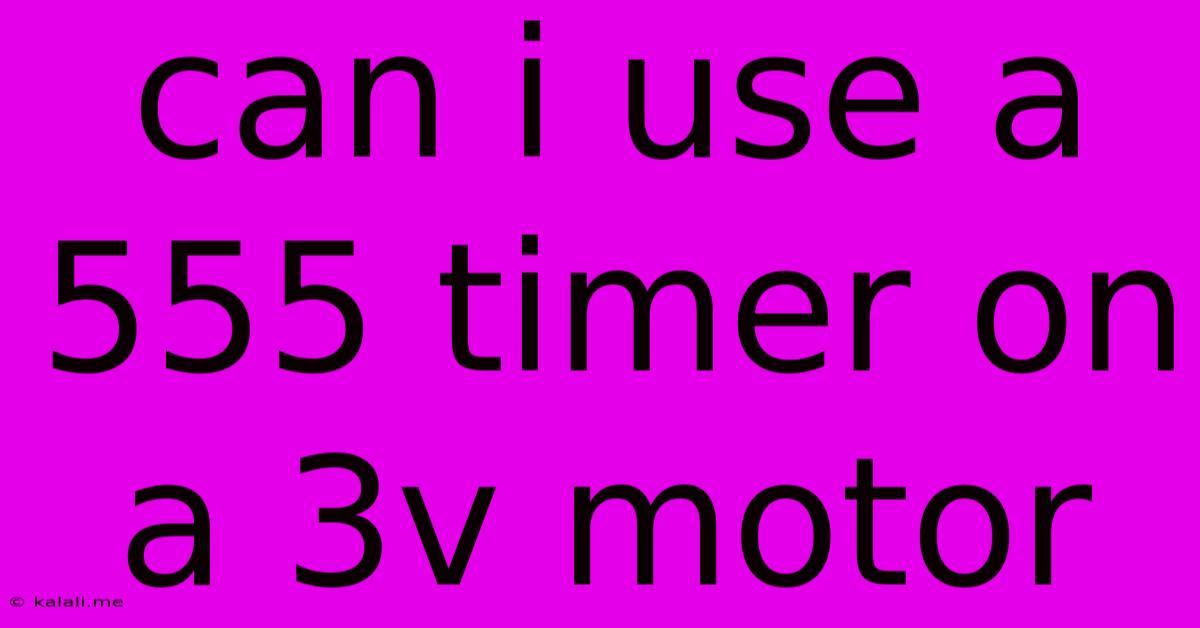Can I Use A 555 Timer On A 3v Motor
Kalali
Jun 03, 2025 · 4 min read

Table of Contents
Can I Use a 555 Timer to Drive a 3V Motor? The Surprising Answer
So you've got a 555 timer IC and a tiny 3V motor, and you're wondering if you can use the 555 to control it. The short answer is: maybe, but probably not directly. This article will delve into why, exploring the limitations of the 555 timer and outlining practical solutions for driving your 3V motor. Understanding the current requirements of your motor and the 555's output capabilities is crucial.
The 555 timer is a versatile integrated circuit, perfect for creating oscillators, timers, and pulse generators. However, it's not designed to directly drive high-current loads like motors. The 555's output pin can only source or sink a limited amount of current, typically in the tens of milliamps. Most small 3V motors will require significantly more current to operate effectively – often hundreds of milliamps. Trying to drive a motor directly from the 555 will likely result in a weak, sputtering motor, or worse, damage to the 555 itself.
Understanding the Limitations: Current and Voltage
The key limitation lies in the current-sourcing capability of the 555 timer. While the 555 can generate the necessary switching pulses to control a motor, it lacks the power to actually drive the motor's armature. Attempting to bypass this will likely result in overheating and potential failure of the 555 chip.
Furthermore, you need to consider the voltage requirements of your motor. While your motor operates at 3V, the 555 timer's output voltage will also need to be compatible. This is generally not a major issue for 3V motors as long as the proper transistors are used for switching.
Practical Solutions: Using a Transistor as a Switch
The most common and effective solution is to use a transistor as a switch. A transistor acts as an amplifier, allowing the low-current output of the 555 to control the higher-current flow to the motor. Here’s how it works:
- The 555 Timer: This acts as the control unit, generating the on/off pulses that will regulate the motor.
- The Transistor: This acts as a switch, controlled by the 555. When the 555's output is high, the transistor turns on, allowing current to flow to the motor. When the 555's output is low, the transistor turns off, cutting power to the motor.
For a 3V motor, a bipolar junction transistor (BJT) like a 2N2222 or a MOSFET like a 2N7000 would be suitable choices. A MOSFET is generally preferred due to its lower on-resistance, leading to less power loss and better efficiency.
Choosing the Right Transistor and Circuit Design
Selecting the appropriate transistor depends on the motor's current draw. You'll need a transistor with a collector/drain current rating significantly higher than the motor's stall current. Always check the transistor's datasheet to ensure it's suitable for your application.
A simple circuit would involve connecting the 555's output to the base of a BJT (through a current-limiting resistor) or the gate of a MOSFET. The motor would be connected to the collector/drain and the negative supply rail. This setup allows the 555 to control the motor's power supply, effectively driving the motor without overloading the 555.
Beyond the Basics: Motor Drivers and Pulse Width Modulation (PWM)
For more complex motor control, consider using a dedicated motor driver IC. These chips are designed to handle the high currents required by motors and often provide additional features like over-current protection. These are particularly useful for higher-power motors or applications requiring precise speed control.
Using Pulse Width Modulation (PWM) with the 555 timer offers a way to control the motor's speed. By varying the duty cycle of the pulses sent to the transistor, you can effectively control the average voltage supplied to the motor, thus controlling its speed.
In conclusion, while you can't directly drive a 3V motor with a 555 timer, employing a transistor as a switch is a straightforward and efficient solution. Understanding the current requirements of your motor and selecting the appropriate components are crucial for success. Using a dedicated motor driver or PWM for more sophisticated control further enhances the capabilities of your system. Remember to always consult datasheets and prioritize safe circuit design practices.
Latest Posts
Latest Posts
-
Show Disc Space Usage Of Specific Users
Jun 05, 2025
-
Stop Apache Showing Full Server Path In Browser
Jun 05, 2025
-
How To Make A Sticker Stick More
Jun 05, 2025
-
Can You Remove Trust From Attic Ceiling
Jun 05, 2025
-
How To Remove Bathroom Fan Cover
Jun 05, 2025
Related Post
Thank you for visiting our website which covers about Can I Use A 555 Timer On A 3v Motor . We hope the information provided has been useful to you. Feel free to contact us if you have any questions or need further assistance. See you next time and don't miss to bookmark.